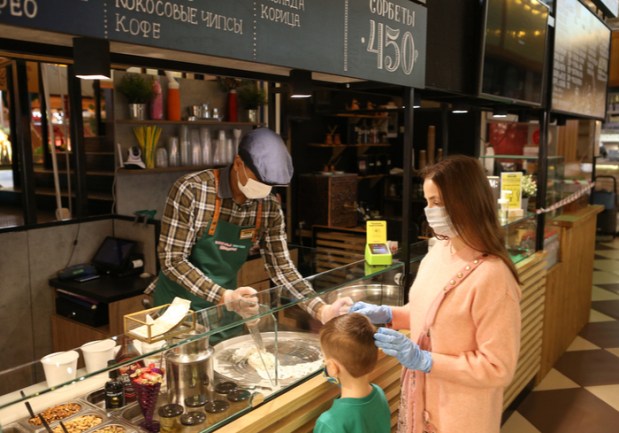Does The Merchant And Consumers’ Disconnect On The Pandemic’s Length Signal Trouble?

By the numbers, Main Street merchants are feeling a little bit better these days than they were six months ago when the pandemic began, according to the latest PYMNTS Main Street business survey. Some 54 percent now report feeling confident they’ll survive through the outbreak’s end — a notable improvement from the 42 percent that thought the same in late March. And nearly a quarter of SMBs (24 percent) report their financial situation has improved since COVID-19’s dark early days when widespread shutdowns were taking effect.
But the good news comes with a few caveats. First, many Main Street businesses that reported improved finances since March were already financially stable to begin with. PYMNTS’ latest survey found that 69 percent of the SMBs who said they’re not at risk of failing now weren’t worried that much that their business would shutter as a result of the pandemic-forced closures.
Of those who told PYMNTS in mid-March that they wouldn’t survive the pandemic, only 30 percent have since changed their minds.
The flip side is that among those who initially reported instability, 58 percent said most recently that their finances haven’t changed much since March and their businesses are still at risk of closing.
Only 12 percent said their financial situation has improved, but not so much that they’re no longer at risk of closing. The rising tide of recovery, it seems, is not lifting all boats evenly.
A Disagreement Over The Pandemic’s End Date
But there’s a bigger concern in the figures PYMNTS just released — a fairly big disconnect between Main Street SMB owners and consumers about just how long the pandemic period is going to last. It’s a difference of opinion that’s getting bigger the more confident SMBs become about their futures.
This disconnect could become a dangerous pitfall should the U.S. economy hit another round of shutdowns as summer gives way to fall and colder temperatures sweep the country.
PYMNTS’ latest data find that Main Street businesses and consumers are both gearing up for a longer disruption than they originally expected when the pandemic began. At the outset, the average Main Street business believed the pandemic would last 177 days — an estimate that now on average has stretched out to 248 days from now (September 2020), or roughly another seven months.
Consumers at the start of COVID-19 were estimating a shorter downturn than SMB owners expected — just 145 days. But their expectations have become bleaker as the pandemic continues: Consumers seem resigned that it will take another 371 days left for them to feel fully comfortable reengaging in the physical world as they did in January. That means that consumers now think the pandemic is going to last four months longer than the merchants who own the stores they shop at say it will.
Also notable — and perhaps concerning — is that the more confident a business is that it will survive, the shorter it thinks the pandemic will ultimately be. Main Street businesses that say they are at risk of closing before the pandemic ends believe it will take an average of 276 days before they recover from the pandemic’s impact. Those who report themselves not at risk only expect it to take an average of 204 days to recover.
Overall, the mismatch between consumer and business perceptions of how much longer we have to go is concerning given the overall precarious position many SMBs find themselves in entering the holiday shopping season in terms of revenue and cash flow.
The Clouds Dotting The Horizon
Many Main Street businesses are operating these days with very little margin for error, as cash-flow shortages are nearly endemic in the segment. Some 72 percent of SMBs surveyed reported not having enough cash on hand to withstand 30 days of revenue shortfall. In fact, 39.3 percent of firms said they only have enough funding on hands to stay open for one week or less if the sales engine stalls.
And while revenues are rebuilding as businesses reopen, they’ve not fully returned. Some 75 percent of SMBs surveyed reported that revenues have yet to recover to pre-pandemic levels.
However, COVID-19’s impact on firms’ bottom lines depends considerably on which industry a company is in. For instance, restaurants were the most likely to say the pandemic has significantly decreased their revenues, with 94 percent saying so.
The alarming takeaway from all of this is that reopening alone isn’t going to solve Main Street businesses’ revenue pictures. Many firms seem likely to see reduced earnings until the pandemic itself fully subsides.
However, many SMBs firms are counting on it subsiding significantly earlier than their consumers expect it to. If businesses’ hopes of survival are pinned on the dates SMBs told PYMNTS they expected the outbreak to end, that’s worrisome.
Also concerning, of course, is the uncertainty surrounding the pandemic going into the fall and winter. Will case numbers skyrocket with the colder weather (as can happen with the flu), forcing new shutdowns? Will there be additional U.S. government PPP funding available in the event of another massive setback for the economy? Will a vaccine surface earlier than expected and bring this all to an end sooner than expected?
Those questions remain unanswerable. Yes, it’s encouraging to see Main Street businesses feeling more confidence heading into autumn than they were heading into spring. But it’d be more encouraging if that confidence was accompanied by a notable diminishment in the cash crunch squeezing so many businesses, or a big boost in sales returning to pre-pandemic levels.
